Complete Solutions to QUESTION of chapter JEE ADVANCED 2021 of Class 12 book with complete answers and questions
| Class 12 | CHEMISTRY |
| Chapter | JEE ADVANCED 2021 |
| JEE ADVANCED PREVIOUS YEAR | QUESTION |
| Number Of Questions | 38 |
| Academic Year | 2023-24 |
Match the following columns
 04:38View Solution
04:38View SolutionAmong the following conformation that corresponds to the most stable conformation of meso-butane-2,3-diol is
03:37View SolutionFor the given closed packed structure of a salt made of cation X and anion Y shown below(ions of only one face are shown for clarity), the packing fraction is
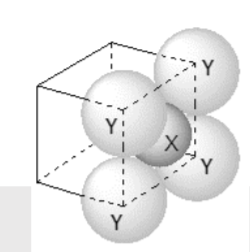 06:54View Solution
06:54View SolutionThe calculated spin only magnetic moments of `[Cr(NH_3)_6]^(3+)` and `[CuF_6]^(3-)` in BM respectively are
03:49View SolutionFor the following reaction scheme, percentage yields are given along the arrows:
 The value of "x" is06:41View Solution
The value of "x" is06:41View SolutionFor the following reaction scheme, percentage yields are given along the arrows:
 The value of "y" is15:16View Solution
The value of "y" is15:16View SolutionFor the reaction , `X(s) harr Y(s) + Z(g)`, the plot of ln`(pz)/p^(theta)` versus `10^4/T` is given below (in solid line), where `p_z` is the pressure (in bar) of the gas at temperature T and `p^(theta)`= 1bar
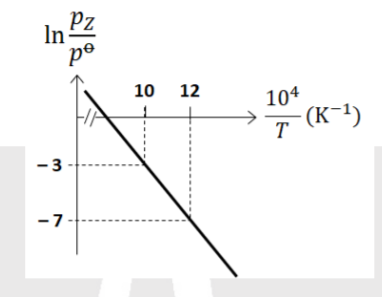
( Given, `(d(lnK))/(d(1/T))= - (DeltaH^(theta))/R`, where the equilibrium constant , `K= p_z/p^(theta)` and the gas constant, R=8.314`JK^(-1)mol^(-1)`
The value of standard enthalpy,`DeltaH^(theta)`(in `kjmol^(-1)`) for the given reaction is ---------`04:46View SolutionFor the reaction , `X(s) harr Y(s) + Z(g)`, the plot of ln`(pz)/p^(theta)` versus `10^4/T` is given below (in solid line), where `p_z` is the pressure (in bar) of the gas at temperature T and `p^(theta)`= 1bar

( Given, `(d(lnK))/(d(1/T))= - (DeltaH^(theta))/R`, where the equilibrium constant , `K= p_z/p^(theta)` and the gas constant, R=8.314`JK^(-1)mol^(-1)`
The value of `DeltaS^(theta)`(in `jmol^(-1)`) for the given reaction at 1000K is ---------`04:46View SolutionThe boilingpoint of water in a 0.1 molal silver nitrate solution(solutionA) is `x^@C`. To this solution A, an equal volume of 0.1 molal aqueous barium chloride solution is added to make a mew solution B. The difference in the boiling points of water in the two solutions A and B is `yxx10^(-2)"^@C`
(Assume: Densities of the solutions A and B are the same as that of water and soluble salts dissociate completely.
Use:molal elevation constant (Ebullioscopic constant),`K_b= 0.5Kkgmol^(-1)` Boiling point of pure water as `100^@C`)
The value of x is ---------.11:03View SolutionThe boilingpoint of water in a 0.1 molal silver nitrate solution(solutionA) is `x^@C`. To this solution A, an equal volume of 0.1 molal aqueous barium chloride solution is added to make a mew solution B. The difference in the boiling points of water in the two solutions A and B is `yxx10^(-2)"^@C`
(Assume: Densities of the solutions A and B are the same as that of water and soluble salts dissociate completely.
Use:molal elevation constant (Ebullioscopic constant),`K_b= 0.5Kkgmol^(-1)` Boiling point of pure water as `100^@C`)
The value of `abs(y)` is ---------.11:03View Solution
The compound, which on reaction with `HNO_3` will give the product having degree of rotation, `[alpha]_D`= `-52.7^@ is(are)05:46View SolutionThe reaction of Q with PhSNa yields an organic compound(major product) that gives positive Carius test on treatment with `Na_2O_2` followed by addition of `BaCl_2`. The correct option(s) for Q is(are)
09:04View SolutionThe correct statement(s) related to colloids is(are)
08:17View SolutionAn ideal gas undergoes a reversible isothermal expansion from state I to state II followed by a reversible adiabatic expansion from state II to state III. The correct plot(s) representing the changes from state I to state III is(are)
05:12View SolutionThe correct statement(s) related to the metal extraction processes is(are)
06:19View SolutionA mixture of two salts is used to prepare a solution S, which gives the following results:

The correct option(s) for the salt mixture is(are)08:19View SolutionThe maximum number of possible isomers(including stereoisomers) which may be formed on mono-bromination of 1-methylcyclohex-1-ene using `Br_2` and UV light is-----------.
05:45View SolutionIn the reaction given below, the total number of atoms having `sp^2` hybridization in the major product P is--------------`
 04:51View Solution
04:51View SolutionThe total number of possible isomers for `[Pt(NH_3)_4Cl_2]Br_2` is --------------.
03:59View SolutionThe reaction sequence(s) that would lead to o-xylene as the major product is(are)
09:21View SolutionCorrect option(s) for the following sequence of reactions is(are)
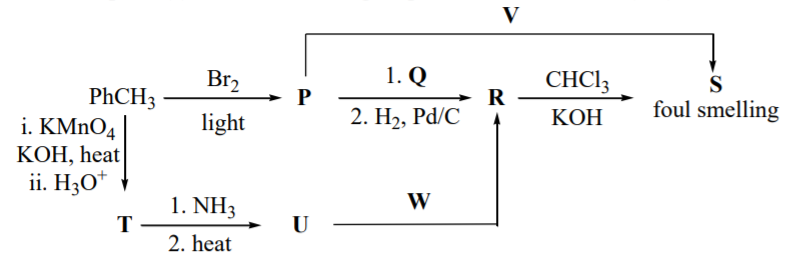 11:03View Solution
11:03View SolutionFor the following reaction
`2X+Y overset(K)rarrP`
the rate of reaction is `(d[P])/dt= K[X]`. Two moles of X are mixed with 1mole of Y to make 1.0L of solution. At 50s, 0.5mole of Y is left in the reaction mixture. The correct statement(s) about the reaction is(are)05:23View SolutionSome standard electrode potentials at 298K are given below:
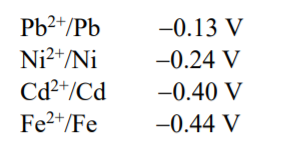
To a solution containing 0.001M of `X^(2+)` and 0.1M of `Y^(2+)`, the metal rods X and Y are inserted (at298K) and connected by a conducting wire. This resulted in dissolution of X. The correct combinations of X and Y, respectively is (are)
(Given: Gas constant, `R=8.314JK^(-1)mol^(-1)`, Faraday constant,F= 96500C`mol^(-1)`)08:34View SolutionThe pair(s) of complexes where in both exhibit tetrahedral geometry is(are)
02:35View SolutionThe correct statement(s) related to oxoacids of phosphorous is(are)
06:42View SolutionAt 298K, the limiting molar conductivity of a weak monobasic acid is `4xx10^2Scm^2mol^(-1)`. At 298K, for an aqueous solution of the acid the degree of dissociation is `alpha` and the molar conductivity is `yxx10^2Scm^2mol^(-1)`. At 298K, upon 20times dilution with water, the molar conductivty of the solution becomes `3yxx10^2Scm^2mol^(-1)` The value of `alpha` is
04:26View SolutionAt 298K, the limiting molar conductivity of a weak monobasic acid is `4xx10^2Scm^2mol^(-1)`. At 298K, for an aqueous solution of the acid the degree of dissociation is `alpha` and the molar conductivity is `yxx10^2Scm^2mol^(-1)`. At 298K, upon 20times dilution with water, the molar conductivty of the solution becomes `3yxx10^2Scm^2mol^(-1)` The value of y is
04:26View SolutionReaction of xg of Sn with HCl quantitatively produced a salt. Entire amound of the salt reacted with yg of nitrobenzene in the presence of required amount of HCl to produce 1.29g of an organic salt(quantitatively).
(Use Molar masses (in gmol^(-1)) of H,C,N,O,Cl and Sn as 1,12,14,16,35 and 119 respectively). The value of x is ----------.04:08View SolutionReaction of xg of Sn with HCl quantitatively produced a salt. Entire amound of the salt reacted with yg of nitrobenzene in the presence of required amount of HCl to produce 1.29g of an organic salt(quantitatively).
(Use Molar masses (in `gmol^(-1))` of H,C,N,O,Cl and Sn as 1,12,14,16,35 and 119 respectively). The value of is ----------.y04:08View SolutionA sample (5.6g) containing iron is completely dissolved in cold dilute HCl to prepare a 250ml of solution. Titration of 25.0ml of this solution requires 12.5ml of 0.03M `KMnO_4` solution to reac the end point. Number of moles of `Fe^(2+)` present in 250ml solution is `Xxx10^(-2)`(consider complete dissolution of `FeCl_2`). The amont of iron present in the sample is y% by weight
Assume: `KMnO_4` reacts with `Fe^(2+)` in the solution
Use: Molear mass of iron as 56`gmol^(-1)` The value of X is------.03:26View SolutionA sample (5.6g) containing iron is completely dissolved in cold dilute HCl to prepare a 250ml of solution. Titration of 25.0ml of this solution requires 12.5ml of 0.03M `KMnO_4` solution to reac the end point. Number of moles of `Fe^(2+)` present in 250ml solution is `Xxx10^(-2)`(consider complete dissolution of `FeCl_2`). The amont of iron present in the sample is y% by weight
Assume: `KMnO_4` reacts with `Fe^(2+)` in the solution
Use: Molear mass of iron as 56`gmol^(-1)` The value of is------.y03:26View SolutionThe amount of energy required to break a bond is same as the amount of energy released when the same bond is formed. In gaseous state, the enrgy required for hololytic cleavage of a bond is called Bond Dissociation Energy(BDE) or Bond Strength. BDE is affected by s-character of the bond and the stability of the radicals formed. Shorter bonds typically stronger bonds. BDEs for some bonds are given below:
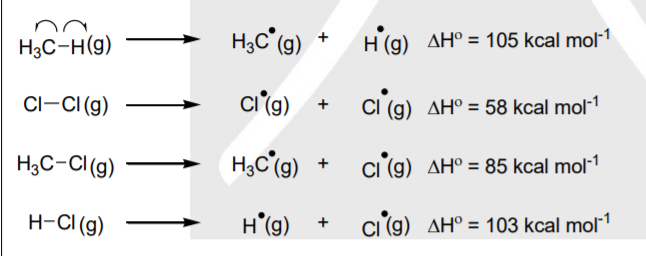
Correct match of the C-H bonds(shown in bold) in column J with their BDE in column K is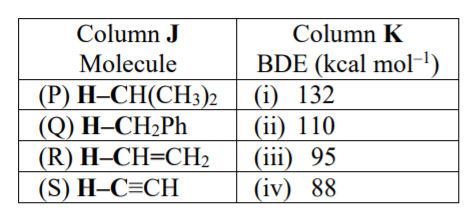 06:05View Solution
06:05View SolutionThe amount of energy required to break a bond is same as the amount of energy released when the same bond is formed. In gaseous state, the enrgy required for hololytic cleavage of a bond is called Bond Dissociation Energy(BDE) or Bond Strength. BDE is affected by s-character of the bond and the stability of the radicals formed. Shorter bonds typically stronger bonds. BDEs for some bonds are given below:

For the following reaction
`CH_4(g) + Cl_2(g) overset(light)rarr CH_3Cl(g) + HCl(g)`
the correct statement is06:30View SolutionThe reaction of `K_3[Fe(CN)_6]` eith freshly prepared `FeSO_4` solution procues a dark blue precipitate caleed Turnbull's blue. Reaction of `K_4[Fe(CN)_6]` with the `FeSO_4` solution in complete absence of air produces a white precipitate X, which turns blue in air. Mixing the `FeSO_4` solution with `NaNO_3`, followed by a slow addition of concentrated `H_2SO_4` through the side of the test tube produces a brown ring.
Precipitate X is03:00View SolutionThe reaction of `K_3[Fe(CN)_6]` eith freshly prepared `FeSO_4` solution procues a dark blue precipitate caleed Turnbull's blue. Reaction of `K_4[Fe(CN)_6]` with the `FeSO_4` solution in complete absence of air produces a white precipitate X, which turns blue in air. Mixing the `FeSO_4` solution with `NaNO_3`, followed by a slow addition of concentrated `H_2SO_4` through the side of the test tube produces a brown ring.
Among the following, the brown ring is due to the formation of03:00View Solution1 mole of an ideal gas at 900K, undergoes 1 reversible processes, I followed by II, as shown below. If the work done by the gas in the 2 processes are same, the value of `ln(V_3/V_2) ` is -------.

(Given: molar heat capacity at constant volume, `C_(V,m)` of the gas is `5/2R`)07:20View SolutionConsider a helium(He) atom that absorbs a photon of wavelength 330nm. The change in the velocity (in `cms^(-1)`) of He atom after the photon absorption is------.
(Assume: Momentum is consrves when photon is absorder.
Use:Plank constant=`6.6xx10^(-34)Js`, Avogadro number= `6xx10^(23)mol^(-1)`, molar mass of He= `4gmol^(-1)`01:39View SolutionOzonolysis of `ClO_2` produces an oxide of chlorine. The average oxidation state of chlorine in this oxide is------.
02:25View Solution
QUESTION questions and complete solutions for chapter JEE ADVANCED 2021 of JEE ADVANCED PREVIOUS YEAR of Class 12
